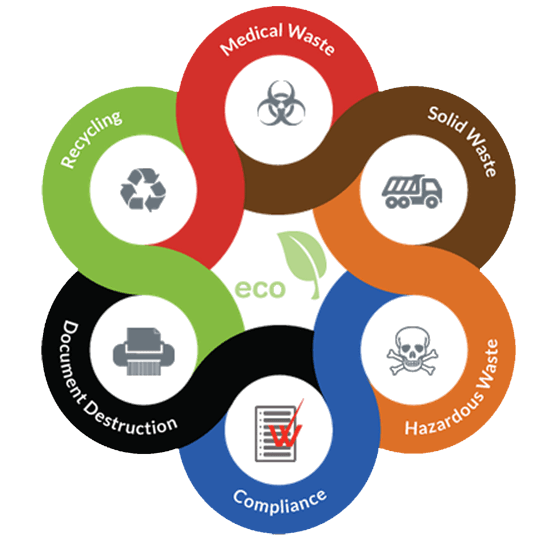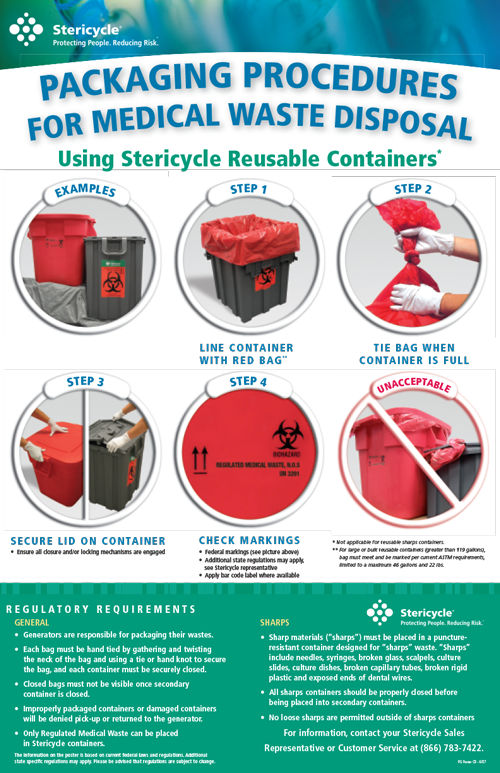Best Practices for Medical Waste Management
Medical waste administration is a vital element of medical care centers' operations to make certain the safety of patients, staff, and the atmosphere. Applying best methods in medical waste management is vital to lessen the risks related to dangerous waste. This consists of proper segregation and categorization of waste, guaranteeing its safe storage and labeling, sticking to regulatory guidelines, and utilizing reliable disposal approaches. By complying with these best methods, healthcare centers can lower the capacity for infections, injuries, and pollution brought on by inappropriate handling and disposal of medical waste. This intro intends to offer an introduction of the importance of best techniques for medical waste management and the subsequent sections will delve right into each practice in detail.
Segregation and Categorization
In the field of clinical waste monitoring, proper segregation and categorization are crucial methods for guaranteeing the safe and effective disposal of healthcare-related products. Clinical waste is generated from numerous resources, including healthcare facilities, clinics, labs, and other health care centers. It contains a broad array of items, such as needles, syringes, plasters, gloves, and pharmaceutical waste.
Partition includes the methodical splitting up of various types of medical waste based on their characteristics and potential risks. Sharps waste, such as needles and blades, ought to be positioned in puncture-resistant containers to protect against injuries and the spread of contagious diseases.
Classification is the process of categorizing clinical waste into different categories based upon its prospective threats. WasteX Medical Waste Disposal. These categories might consist of transmittable waste, contaminated materials, pharmaceutical waste, and basic waste. By categorizing waste, medical care facilities can identify the ideal disposal techniques and guarantee compliance with neighborhood regulations and guidelines
Proper partition and classification of clinical waste not just protect the health and wellness and safety of health care workers and the public but likewise add to the total effectiveness and effectiveness of waste administration. It reduces the danger of crashes, minimizes environmental influences, and promotes accountable waste disposal techniques.
Appropriate Storage Space and Identifying
To guarantee the secure and reliable disposal of clinical waste, healthcare facilities must stick to appropriate storage space and labeling techniques. Appropriate storage space and labeling play an important duty in preserving the integrity of clinical waste monitoring systems and securing the wellness and security of healthcare employees, individuals, and the public.
When it comes to storage, it is important to have assigned locations specifically made for various kinds of clinical waste. These areas should be secure, well-ventilated, and outfitted with proper containers that meet regulative requirements. Partition and categorization of waste should likewise be considered to avoid cross-contamination and possible risks.
Additionally, appropriate labeling is crucial for effective waste administration. Each container needs to be clearly classified with the appropriate icons, color-coding, and info concerning the waste it contains. Tags ought to include information such as the kind of waste, day of collection, and the name of the generator. This makes certain that all individuals handling the waste can easily recognize and handle it appropriately.
Normal monitoring and assessment of storage space areas and containers are vital to identify any kind of concerns or infractions. Team should be trained on appropriate storage and labeling methods, emphasizing the relevance of conformity with procedures and regulations.
Safe Transport and Handling
Ensuring the protected and correct transportation and handling of medical waste is crucial for preserving the stability of waste monitoring systems and safeguarding the health and wellness of all involved. Medical waste, that includes items infected with transmittable materials, pharmaceuticals, and other unsafe materials, must be transferred in a fashion that prevents leaks, spills, and possible contamination.
To attain risk-free transportation and handling, numerous ideal methods ought to be adhered to. It is crucial to use watertight and puncture-resistant containers that are specifically developed for clinical waste. These containers should be correctly sealed and identified to avoid any kind of unexpected exposure or messing up. In addition, waste should be set apart based upon its nature and kind to protect against cross-contamination.
Throughout transport, it is essential to guarantee that waste containers are firmly fastened and kept in a stable way. Cars made use of for delivering clinical waste should be geared up with proper safety functions, such as spill containment systems, to lessen the risk of any leaks or spills (medical waste disposal). Vehicle drivers need to obtain training on proper handling and emergency situation feedback procedures to efficiently attend to any kind of unforeseen occurrences
Moreover, the transport and handling of medical waste should adhere to all relevant regulations and guidelines established forth by local, state, and government authorities. Routine assessments and audits need to be conducted to examine conformity and determine any areas for improvement.

Compliance With Regulatory Standards
Preserving conformity with regulative guidelines is necessary for reliable medical waste administration. These standards are established to shield public health and wellness and the setting by making certain that clinical waste is correctly taken care of, dealt with, and disposed of. medical waste disposal. Compliance with regulatory guidelines helps to avoid read this post here the spread of infectious conditions, reduce possible risks, and decrease the overall effect of medical waste on the atmosphere
To achieve conformity, health care facilities have to stay educated concerning the details laws governing clinical waste management in their territory. These regulations may vary from country to nation, and even within various states or areas. It is necessary for healthcare centers to have an extensive understanding of these standards and to implement ideal approaches and procedures to make certain conformity.
One secret element of compliance is the proper segregation and labeling of different kinds of medical waste. This consists of dividing sharps from other waste, in addition to categorizing waste based upon its prospective threats. Medical care facilities should likewise make sure that medical waste is saved in proper containers which these containers are properly labeled and secured.
Moreover, compliance with regulatory standards needs health care centers to establish proper training and education programs for employee entailed in clinical waste management - WasteX Medical Waste Disposal. This consists of giving training on waste partition, managing, and disposal treatments, in addition to the proper use of individual safety devices
Regular monitoring and audits are additionally important to make sure recurring conformity with governing guidelines. This entails carrying out normal examinations of waste storage space areas, documenting waste monitoring treatments, and keeping records of waste disposal.
Effective Disposal Techniques
Medical care facilities need to use efficient disposal approaches for proper monitoring of clinical waste - WasteX Medical Waste Disposal. Inappropriate disposal of clinical waste can posture severe health and wellness and environmental dangers. There are numerous approaches that can be used to efficiently deal with medical waste, making certain the safety and security of health care workers, patients, and the general public
One commonly used method is incineration. Burners can securely burn medical waste at high temperatures, minimizing the quantity and destroying any kind of potentially hazardous pathogens. However, incineration can be expensive and might release damaging contaminants into the air if not effectively regulated.
One more technique is autoclaving, which entails subjecting the waste to high-pressure vapor. This process eliminates microorganisms, viruses, and other microorganisms, making the waste safe for disposal in regular waste streams. Autoclaving is a effective and eco-friendly approach, yet it needs customized equipment and experienced workers.
Chemical sanitation is likewise utilized in some cases, where fluid chemicals are put on the waste to sanitize it. This method is less typically utilized due to problems concerning the efficiency of chemical disinfection and the capacity for chemical deposits to contaminate the atmosphere.
Along with these methods, health care centers must also apply proper partition, product packaging, and labeling of medical waste to ensure its safe handling and disposal. Normal training and education of personnel on appropriate waste monitoring practices are essential to maintaining effective disposal approaches.
Final Thought

Medical waste monitoring is a critical aspect of healthcare facilities' procedures to make certain the safety and security of people, personnel, and the atmosphere. Executing ideal practices in clinical waste management is vital to lessen the dangers connected with hazardous waste. These classifications might include infectious waste, dangerous waste, pharmaceutical waste, and general waste.In conclusion, carrying out finest methods for clinical waste management is vital for ensuring the security of health care employees, clients, and the environment. By correctly segregating and classifying waste, saving and labeling it properly, ensuring risk-free transport and handling, complying with regulatory standards, and utilizing effective disposal approaches, health care centers can properly manage and decrease the threats associated with medical waste.